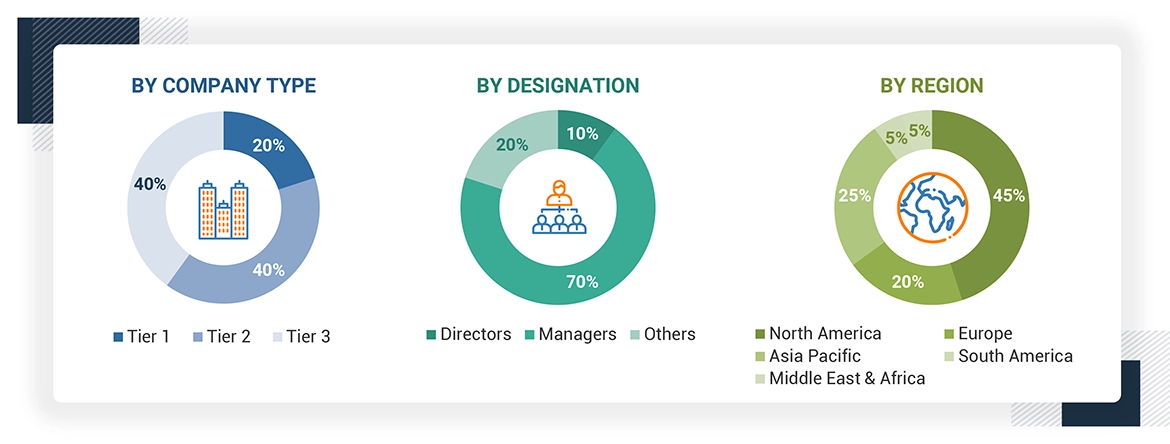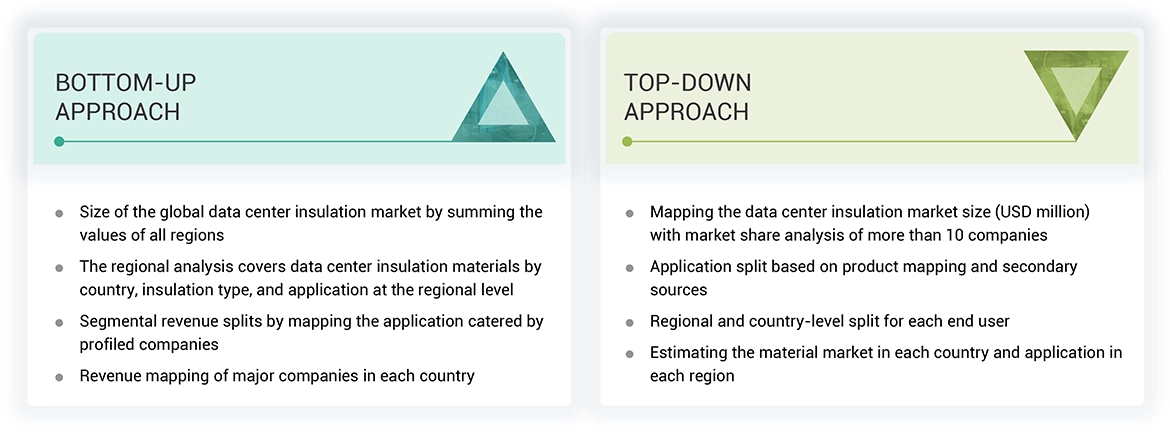The research methodology used in estimating the current size of the data center insulation market included four major activities. Extensive secondary research was performed to acquire detailed information about the market, peer markets, and parent markets. These findings, assumptions, and metrics were verified through primary research with experts from both the demand side of the data center insulation value chain. Both top-down and bottom-up approaches were used to estimate the total market size. The estimation of market sizes of various segments and subsegments in the market was done finally with the help of full market segmentation and data triangulation techniques.
Secondary Research
The research methodology for estimating and forecasting the data center insulation market begins with gathering data on key vendors' revenues by doing secondary research. Secondary research process involves consulting a range of secondary sources, including Hoovers, Bloomberg BusinessWeek, Factiva, the World Bank, and industry journals. These secondary sources encompass annual reports, press releases, investor presentations, white papers, certified publications, articles from recognized authors, regulatory notifications, trade directories, and databases. Also, vendor offerings are taken into consideration to inform market segmentation.
Primary Research
The data center insulation market comprises of several stakeholders in the supply chain, such as raw material suppliers, manufacturers, distributers, contractors/sub-contractors, infrastructure OEM and system integrators and end users. The demand side of this market is defined by the development of information technology, telecommunications, finance and banking, retail and e-commerce, healthcare, government & public sector and education. Interviews were conducted with a range of primary sources on both the supply and demand sides of the market to gather both qualitative and quantitative data. Following is the breakdown of the primary respondents:
Following is the breakdown of the primary respondents:

To know about the assumptions considered for the study, download the pdf brochure
Market Size Estimation
Top-down and bottom-up approaches were both used to estimate and validate the size of the data center insulation market. These methods were used to determine the market size of various segments. The research methodology used for the market size estimation is as follows:
-
Extensive primary and secondary research was done to identify the key players.
-
The value chain and market size of the data center insulation market, in terms of value, were determined through primary and secondary research.
-
All percentage shares, splits, and breakdowns were collected through secondary sources and verified through primary sources.
-
All possible parameters that affect the market were covered in this research study and are viewed in extensive detail, verified through primary research, and analyzed to obtain the final quantitative and qualitative data.
-
The study of reports, reviews, and newsletters of top market players, along with extensive interviews for opinions from key leaders, such as CEOs, directors, and marketing executives are included in this research.

Data Triangulation
After estimating the overall market size using the above estimation the market was split into various segments and subsegments. Data triangulation and market breakup techniques, along with the market engineering process, were used to reach the exact market analysis data for each segment and subsegment. Research Methodology The research methodology used to estimate and forecast the global market size began by first aggregating data and information from the country level as well as from different levels.
Market Definition
The insulation market in data centers already plays a vital role in improving energy efficiency and sustainability since such data centers consume about 1% of the total global energy and emit around 2% of the greenhouse gases. The cooling systems can run as high as 40% of the total operational cost, mostly driven by continuous heat generated by the servers. Cooling equipment, piping, and distribution systems should be insulated to help prevent heat loss or gain and control condensation, thus helping to reduce component failures and keep the environment clean and free of dust. High-quality insulation materials like Mineral Wool and Polyurethane Foam have beneficial side effects: a positive impact on thermal management and energy waste in data centers has an overall good effect on the carbon footprint of such establishments. Data centers can improve PUE by a high margin to support global sustainability through the implantation of high-level insulation solutions.
Stakeholders
-
Data Center Operators and Insulation Material Manufacturers
-
Data Center Construction Companies and HVAC and Cooling System Providers
-
Engineering and Consulting Firms and Data Center Equipment Manufacturers
-
Associations and Industrial Bodies such as the ASHRAE (American Society of Heating, Refrigerating, and Air-Conditioning Engineers), Uptime Institute, The Green Grid, BICSI (Building Industry Consulting Service International), and Others
-
NGOs, Governments, Investment Banks, Venture Capitalists, and Private Equity Firms
Report Objectives
-
To define, describe, and forecast the size of the global data center insulation market in terms of value.
-
To provide detailed information regarding the key factors, such as drivers, restraints, opportunities, and industry-specific challenges, influencing the growth of the data center insulation market
-
To analyze and forecast the size of various segments (insulation, material, and application) of the data center insulation market based on five major regions—North America, Europe, Asia Pacific, South America, Middle East & Africa—along with key countries in each of these regions.
-
To analyze recent developments and competitive strategies, such as expansions, new product developments, partnerships, and acquisitions, to draw the market's competitive landscape.
-
To strategically profile the key players in the market and comprehensively analyze their core competencies.



Growth opportunities and latent adjacency in Data Center Insulation Market